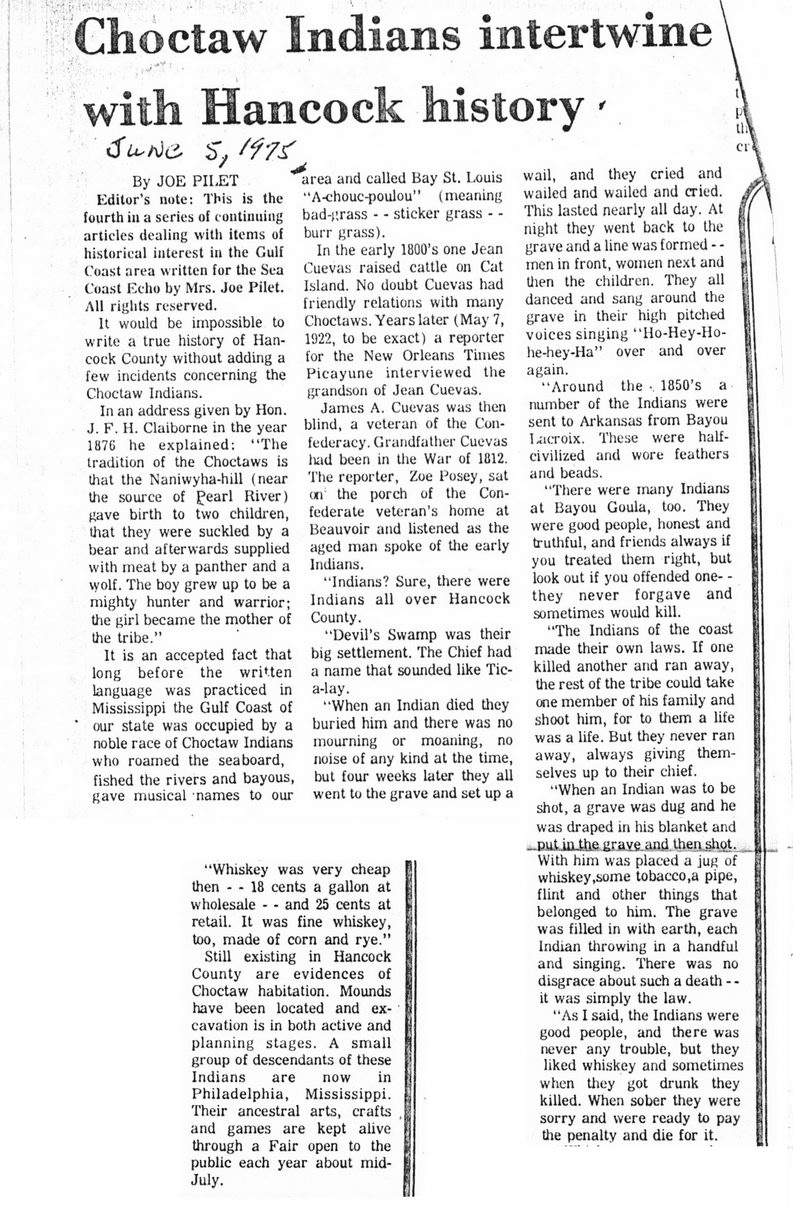This text was obtained via automated optical character recognition.
It has not been edited and may therefore contain several errors.
Choctaw Indians intertwine ji* with Hancock history' By JOE PILET Editor?s nutc: This is the fourth in a series of continuing articles dealing with items of historical interest in the Gulf Coast area written for the Sea Coast Echo by Mrs. Joe Pilet. All rights reserved. It would be impossible to write a true history of Hancock County without adding a few incidents concerning the Choctaw Indians. In an address given by Hon. J. F. H. Claiborne in the year 1876 he explained: ?The tradition of the Choctaws is that the Naniwyha-hill (near the source of fearl River) gave birth to two children, that they were suckled by a bear and afterwards supplied with meat by a panther and a wolf. The boy grew up to be a mighty hunter and warrior; the girl became the mother of the tribe.? It is an accepted fact that long before the written language was practiced in Mississippi the Gulf Coast of our state was occupied by a noble race of Choctaw Indians who roamed the seaboard, fished the rivers and bayous, gave musical names to our area and called Bay St. Louis ?A-chouc-poulou? (meaning bad-grass - - sticker grass - -burr grass). In the early 1800?s one Jean Cuevas raised cattle on Cat Island. No doubt Cuevas had friendly relations with many Choctaws. Years later (May 7, 1922, to be exact) a reporter for the New Orleans Times Picayune interviewed the grandson of Jean Cuevas. James A. Cuevas was then blind, a veteran of the Confederacy. Grandfather Cuevas liad been in the War of 1812. The reporter, Zoe Posey, sat (ii the porch of the Confederate veteran?s home at Beauvoir and listened as the aged man spoke of tlie early Indians. ?Indians? Sure, there were Indians all over Hancock County. ?Devil?s Swamp was their big settlement. The Chief had a name that sounded like Tic-a-lay. "When an Indian died they buried him and there was no mourning or moaning, no noise of any kind at the time, but four weeks later they all went to the grave and set up a wail, and they cried and wailed and wailed and cried. This lasted nearly all day. At night they went back to the grave and a line was formed - -inen in front, women next and then the children. They all danced and sang around the grave in their high pitched voices singing ?Ilo-Hey-Ho-he-hey-Ha? over and over again. ?Around the ?. 1850?s a number of the Indians were sent to Arkansas from Bayou I?icroix. These were halfcivilized and wore feathers and beads. ?There were many Indians at Bayou Goula, too. They were good people, honest and truthful, and friends always if you treated them right, but look out if you offended one- -they never forgave and sometimes would kill. ?The Indians of the coast made their own laws. If one killed another and ran away, the rest of the tribe could take one member of his family and shoot him, for to them a life was a life. But they never ran away, always giving themselves up to their chief. ?When an Indian was to be shot, a grave was dug and he was draped in his blanket and x. out iii tho tirave and thpn shot With him was placed a jug of whiskey,some tobacco,a pipe, flint and other things that belonged to him. The grave was filled in with earth, each Indian throwing in a handful and singing. There was no disgrace about such a death - -it was simply the law. ?As I said, the Indians were good people, and there was never any trouble, but they liked whiskey and sometimes when they got drunk they killed. When sober they were sorry and were ready to pay the penalty and die for it. ?Whiskey was very cheap then - - 18 cents a gallon at wholesale - - and 25 cents at retail. It was fine whiskey, too, made of corn and rye.? Still existing in Hancock County are evidences of Choctaw habitation. Mounds have been located and excavation is in both active and planning stages. A small group of descendants of these Indians are now in Philadelphia, Mississippi. Their ancestral arts, crafts and games are kept alive through a Fair open to the | public each year about mid- I July. B

Oliver, T Choctaw-Indians-intertwine-with-Hancock-history-June-5-1975